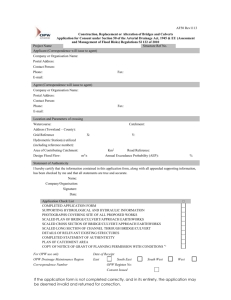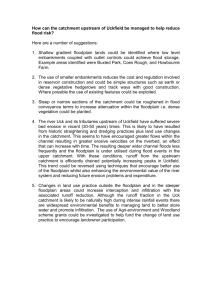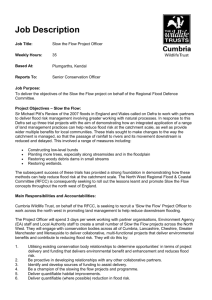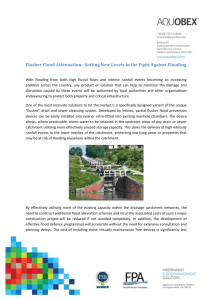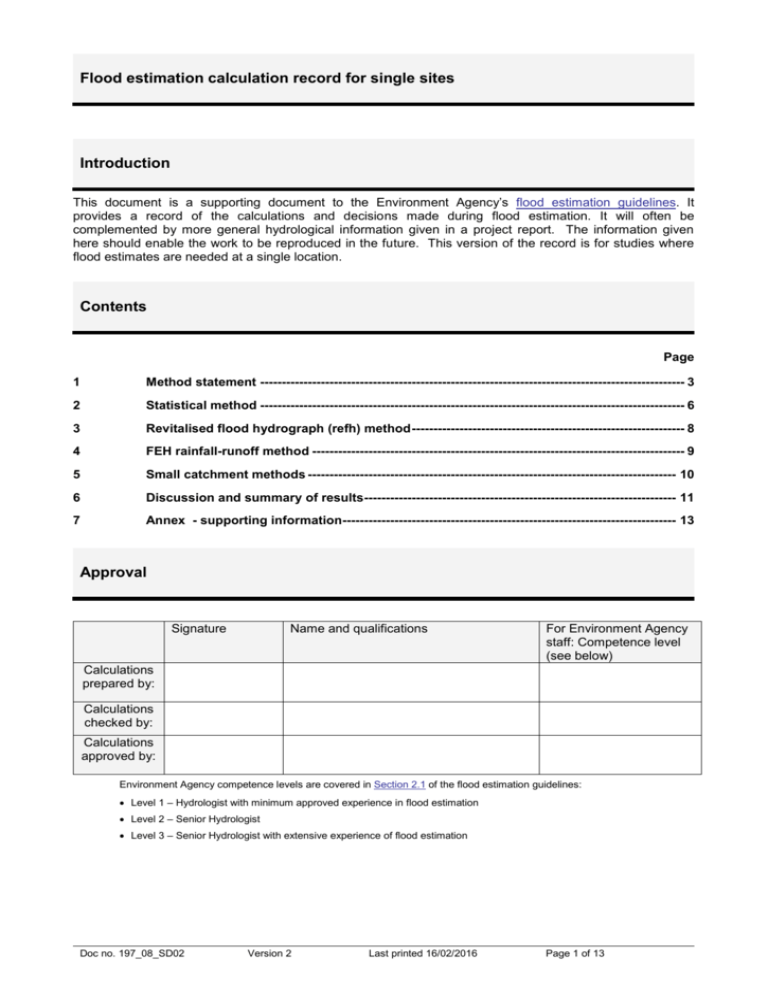
Flood estimation calculation record for single sites
Introduction
This document is a supporting document to the Environment Agency’s flood estimation guidelines. It
provides a record of the calculations and decisions made during flood estimation. It will often be
complemented by more general hydrological information given in a project report. The information given
here should enable the work to be reproduced in the future. This version of the record is for studies where
flood estimates are needed at a single location.
Contents
Page
1
Method statement -------------------------------------------------------------------------------------------------- 3
2
Statistical method -------------------------------------------------------------------------------------------------- 6
3
Revitalised flood hydrograph (refh) method --------------------------------------------------------------- 8
4
FEH rainfall-runoff method -------------------------------------------------------------------------------------- 9
5
Small catchment methods ------------------------------------------------------------------------------------- 10
6
Discussion and summary of results------------------------------------------------------------------------ 11
7
Annex - supporting information----------------------------------------------------------------------------- 13
Approval
Signature
Name and qualifications
For Environment Agency
staff: Competence level
(see below)
Calculations
prepared by:
Calculations
checked by:
Calculations
approved by:
Environment Agency competence levels are covered in Section 2.1 of the flood estimation guidelines:
Level 1 – Hydrologist with minimum approved experience in flood estimation
Level 2 – Senior Hydrologist
Level 3 – Senior Hydrologist with extensive experience of flood estimation
Doc no. 197_08_SD02
Version 2
Last printed 16/02/2016
Page 1 of 13
Abbreviations
AM
AREA
BFI
BFIHOST
CFMP
CPRE
FARL
FEH
FSR
HOST
NRFA
POT
QMED
ReFH
SAAR
SPR
SPRHOST
Tp(0)
URBAN
URBEXT1990
URBEXT2000
WINFAP-FEH
Annual Maximum
Catchment area (km 2)
Base Flow Index
Base Flow Index derived using the HOST soil classification
Catchment Flood Management Plan
Council for the Protection of Rural England
FEH index of flood attenuation due to reservoirs and lakes
Flood Estimation Handbook
Flood Studies Report
Hydrology of Soil Types
National River Flow Archive
Peaks Over a Threshold
Median Annual Flood (with return period 2 years)
Revitalised Flood Hydrograph method
Standard Average Annual Rainfall (mm)
Standard percentage runoff
Standard percentage runoff derived using the HOST soil classification
Time to peak of the instantaneous unit hydrograph
Flood Studies Report index of fractional urban extent
FEH index of fractional urban extent
Revised index of urban extent, measured differently from URBEXT1990
Windows Frequency Analysis Package – used for FEH statistical method
Doc no. 197_08_SD02
Version 2
Last printed 16/02/2016
Page 2 of 13
1
Method statement
1.1
Overview of requirements for flood estimate
Item
Give an overview
which includes:
Comments
Purpose of study
Peak flow or
hydrograph?
Range of return
periods
Approx. time
available
1.2
Overview of catchment
Item
Brief description of
catchment, or
reference to section in
accompanying report
1.3
Comments
Source of flood peak data
Was the HiFlows UK
dataset used? If so,
which version?
Record any changes
made.
1.4
Gauging stations (flow or level)
(at the site of the flood estimate or nearby at potential donor sites)
WaterStation
Gauging
NRFA
Grid
course
name
authority
number
reference
number
(used in
FEH)
1.5
Catchment
area
(km²)
Type
(rated /
ultrasonic
/ level…)
Start and
end of
flow
record
Data available at each flow gauging station
Station
name
Start and
end of
data in
HiFlowsUK
Update
for this
study?
Suitabl
e for
QMED?
Suitabl
e for
pooling
?
Data
quality
check
needed?
Other comments on station
and flow data quality – e.g.
information from HiFlows-UK, trends
in flood peaks, outliers.
Give link/reference to any further
data quality checks carried out
Doc no. 197_08_SD02
Version 2
Last printed 16/02/2016
Page 3 of 13
1.6
Rating equations
Station
name
Type of rating
e.g. theoretical,
empirical; degree of
extrapolation
Rating
review
needed?
Reasons – e.g. availability of recent flow gaugings,
amount of scatter in the rating.
Give link/reference to any rating
reviews carried out
1.7
Other data available and how it has been obtained
Type of data
Data
relevant
to this
study?
Data
available
?
Source of
data and
licence
reference if
from EA
Date
obtained
Details
Check flow gaugings (if
planned to review ratings)
Historic flood data – give
link to historic review if
carried out.
Flow data for events
Rainfall data for events
Potential evaporation
data
Results from previous
studies (e.g. CFMPs,
Strategies)
Other data or
information (e.g.
groundwater, tides)
1.8
Initial choice of approach
Is FEH appropriate? (it may not be for very
small, heavily urbanised or complex
catchments) If not, describe other methods to
be used.
Outline the conceptual model, addressing
questions such as:
What is likely to cause flooding at the site (peak
flows, flood volumes, combinations of peaks,
groundwater, snowmelt, tides…)
Might the site flood from runoff generated on
part of the catchment only, e.g. downstream of a
reservoir?
Is there a need to consider temporary debris
dams that could collapse?
Any unusual catchment features to take into
account?
Doc no. 197_08_SD02
Version 2
Last printed 16/02/2016
Page 4 of 13
e.g.
highly permeable – avoid ReFH if
BFIHOST>0.65, use permeable catchment
adjustment for statistical method if
SPRHOST<20%
highly urbanised – avoid ReFH if
URBEXT1990>0.125; consider FEH Statistical
or other alternatives
pumped watercourse – consider lowland
catchment version of rainfall-runoff method
major reservoir influence (FARL<0.90) –
consider flood routing
extensive floodplain storage – consider choice
of method carefully
Initial choice of method(s) and reasons
Software to be used (with version numbers)
FEH CD-ROM v2.01
WINFAP-FEH v2.0.22 / ReFH spreadsheet / ReFH
Design Flood Modelling Software / ISIS
(delete as applicable or add others)
1.9
Site details
Watercourse
1.10
Easting
Northing
AREA on FEH
CD-ROM
(km2)
Revised AREA
if altered
Catchment descriptors (incorporating any changes made)
FARL
1.11
Site
PROPWET
BFIHOST
DPLBAR
(km)
DPSBAR
(m/km)
SAAR
(mm)
SPRHOST
URBEXT
FPEXT
Checking catchment descriptors
Record how catchment
boundary was checked
and describe any changes
(refer to maps if needed)
Record how other
catchment descriptors
(especially soils) were
checked and describe any
changes. Include
before/after table if
necessary.
Source of URBEXT
URBEXT1990 / URBEXT2000 (delete as applicable or add further details –
note that ReFH should only use URBEXT1990)
Method for updating of
URBEXT
CPRE formula from FEH Volume 4 / CPRE formula from 2006 CEH report
on URBEXT2000 (delete as applicable or add further details)
1
FEH CD-ROM v2.0 © NERC (CEH). © Crown copyright. © AA. 2006. All rights reserved.
2
WINFAP-FEH v2.0.2 © Wallingford HydroSolutions Limited and NERC (CEH) 2006.
Doc no. 197_08_SD02
Version 2
Last printed 16/02/2016
Page 5 of 13
2
Statistical method
2.1
Overview of estimation of QMED
Method
Initial
estimate
of QMED
(m3/s)
NRFA numbers
for donor sites
used (see 3.3)
Data transfer
Distance
Power term,
between
a
centroids
dij (km)
Moderated
QMED
adjustment
factor, (A/B)a
Final estimate
of QMED
(m3/s)
Notes
Methods: AM – Annual maxima; POT – Peaks over threshold; DT – Data transfer; CD – Catchment descriptors alone.
When QMED is estimated from POT data, it should also be adjusted for climatic variation. Details should be added
below.
When QMED is estimated from catchment descriptors, the revised 2008 equation from Science Report SC050050Error!
Bookmark not defined. should be used. If the original FEH equation has been used, say so and give the reason why.
The data transfer procedure is the revised one from Science Report SC050050. The QMED adjustment factor A/B for
each donor site is given in Table 3.3. This is moderated using the power term, a, which is a function of the distance
between the centroids of the subject catchment and the donor catchment. The final estimate of QMED is (A/B) a times
the initial estimate from catchment descriptors.
If more than one donor has been used, give the weights used in the averaging.
2.2
Search for donor sites for QMED
Comment on potential donor sites
Mention:
Number of potential donor sites available
Distances from subject site
Similarity in terms of AREA, URBEXT,
FARL and other catchment descriptors
Quality of flood peak data
Include a map if necessary. Note that donor
catchments should usually be rural.
2.3
Donor sites chosen and QMED adjustment factors
NRFA
no.
2.4
Reasons for choosing or
rejecting
Method
(AM or
POT)
Adjustment for
climatic
variation?
QMED
from
flow data
(A)
QMED from
catchment
descriptors
(B)
Adjustment
ratio
(A/B)
Derivation of pooling group
The composition of the pooling group is given in the Annex.
Target return period (years)
Changes made to default pooling group, with
reasons
Note also any sites that were investigated but
retained in the group.
Doc no. 197_08_SD02
Version 2
100
Distribution and
reason for choice
Last printed 16/02/2016
Parameters (before
urban adjustment) Note
any permeable catchment
adjustments
Page 6 of 13
Target return period (years)
100
Distribution and
reason for choice
Changes made to default pooling group, with
reasons
Note also any sites that were investigated but
retained in the group.
Parameters (before
urban adjustment) Note
any permeable catchment
adjustments
Note: Pooling groups were derived using the original FEH procedures / the revised procedures from Science Report
SC050050 (2008). Delete as applicable.
2.5
Derivation of flood growth curves
Method:
SS – Single site
P – Pooled
J – Joint analysis
If SS, distribution used
and reason for choice
If J, details of averaging
If SS, parameters of
distribution (location, scale
and shape)
Growth factor for
100-year return
period
Note: Growth curves were derived using the original FEH procedures / the revised procedures from Science Report
SC050050 (2008). Delete as applicable.
2.6
Flood estimates from the statistical method
Flood peak (m3/s) for the following return periods (in years)
2
Doc no. 197_08_SD02
Version 2
Last printed 16/02/2016
Page 7 of 13
3
Revitalised flood hydrograph (ReFH) method
3.1
Parameters for ReFH model
Note: If parameters are estimated from catchment descriptors, they are easily reproducible so it is not
essential to enter them in the table.
Method:
Tp (hours)
Cmax (mm)
BL (hours)
BR
OPT: Optimisation
Maximum
Time to peak
Baseflow lag
Baseflow recharge
BR: Baseflow recession fitting
storage
CD: Catchment descriptors
capacity
DT: Data transfer (give details)
Brief description of any flood event analysis
carried out (further details should be given below or
in a project report)
3.2
Design events for ReFH method
Urban or
rural
3.3
Season of design event
(summer or winter)
Storm duration (hours)
Storm area for ARF
(if not catchment area)
Flood estimates from the ReFH method
Flood peak (m3/s) or volumes (m3) for the following return periods (in years)
2
Doc no. 197_08_SD02
Version 2
Last printed 16/02/2016
Page 8 of 13
4
FEH rainfall-runoff method
4.1
Parameters for FEH rainfall-runoff model
Methods:
Rural
(R) or
urban
(U)
4.2
N
o.
FEA : Flood event analysis
LAG : Catchment lag
DT : Catchment descriptors with data transfer from donor catchment
CD : Catchment descriptors alone
BFI : SPR derived from baseflow index calculated from flow data
Tp(0):
method
Tp(0):
value
(hours)
SPR:
method
SPR:
value
(%)
BF:
method
BF:
value
(m3/s)
If DT, numbers of
donor sites used
(see Section 4.2) and
reasons
Donor sites for FEH rainfall-runoff parameters
Watercourse
Station
Tp(0)
from
data (A)
Tp(0)
from
CDs (B)
Adjustment
ratio for
Tp(0) (A/B)
SPR
from
data
(C)
SPR
from
CDs
(D)
1
2
4.3
Inputs to and outputs from FEH rainfall-runoff model
Storm
duration
(hours)
Storm area
for ARF (if
not
catchment
area)
Flood peaks (m3/s) or volumes (m3) for the following return
periods (in years)
2
Are the storm durations likely to be
changed in the next stage of the study, e.g.
by optimisation within a hydraulic model?
Doc no. 197_08_SD02
Version 2
Last printed 16/02/2016
Page 9 of 13
Adjustment
ratio for
SPR
(C/D)
5
Small catchment methods
This section records any estimates of design flows for small catchments using methods other than the FEH.
In this case, the Institute of Hydrology Report 124 method has been used as an alternative. Other methods
can be added or substituted if needed.
5.1
Area
(km2)
Parameters for IH Report 124 method
SAAR4170
(mm)
URBAN
(fraction)
Fraction of catchment covered by WRAP
class (soil types given on Figure I 4.18 in
FSR Volume 5)
1
5.2
2
3
4
Hydrometric area
5
Flood estimates from the IH Report 124 method
Flood peak (m3/s) for the following return periods (in years)
Doc no. 197_08_SD02
Version 2
Last printed 16/02/2016
Page 10 of 13
6
Discussion and summary of results
6.1
Comparison of results from different methods
This table compares peak flows from various methods with those from the FEH Statistical method for two key
return periods. Blank cells indicate that results were not calculated using that method.
Ratio of peak flow to FEH Statistical peak
Return period 100 years
Return period 2 years
ReFH
6.2
Other method
Other method
ReFH
Other method
Other method
Final choice of method
Choice of method
and reasons –
include reference to
type of study,
nature of catchment
and type of data
available.
6.3
Assumptions, limitations and uncertainty
List the main assumptions made
(specific to this study)
Discuss any particular limitations,
e.g. applying methods outside the
range of catchment types or return
periods for which they were
developed
Give what information you can on
uncertainty in the results – e.g.
confidence limits for the QMED
estimates using FEH 3 12.5 or the
factorial standard error from Science
Report SC050050 (2008).
Comment on the suitability of the
results for future studies, e.g. at
nearby locations or for different
purposes.
Give any other comments on the
study, for example suggestions for
additional work.
6.4
Checks
What do the results imply regarding
the return periods of floods during
the period of record?
What is the 100-year growth factor?
Is this realistic? (The guidance
Doc no. 197_08_SD02
Version 2
Last printed 16/02/2016
Page 11 of 13
suggests a typical range of 2.1 to 4.0)
If 1000-year flows have been
derived, what is the ratio for 1000year flow over 100-year flow?
What specific runoff (l/s/ha) does
the design flow equate to?
How do the results compare with
those of other studies? Explain any
differences and conclude which results
should be preferred.
Are the results compatible with the
longer-term flood history?
Describe any other checks on the
results
6.5
Final results
Flood peak (m3/s) or volume (m3) for the following return periods (in years)
2
If flood hydrographs are needed for the next stage of the study,
where are they provided? (e.g. give filename of spreadsheet,
name of ISIS model, or reference to table below)
Doc no. 197_08_SD02
Version 2
Last printed 16/02/2016
Page 12 of 13
7
Annex - supporting information
7.1
Pooling group composition
7.2
Additional supporting information
Doc no. 197_08_SD02
Version 2
Last printed 16/02/2016
Page 13 of 13




